Weaving his way through grief
Larry Romiti was the full-time caregiver for his wife Judy who was living with Alzheimer’s. When the COVID-19 pandemic happened, Judy and Larry found themselves isolated and alone. Larry’s health was failing and on the recommendation of his doctor, Larry moved Judy into a Nevada care setting. After her death in 2023, Larry began expressing his grief through art and started weaving a rug. Larry shares how he used this creative pursuit to work through his grief and find his way back to living his life.
The wild side
When Larry first met Judy in 1980, they were both living on what Larry refers to as “the wild side.” Judy already had children, but that didn’t deter Larry. The two fell in love and bought a house together. Four years later they were married. Larry said, “We thought if we’re going to live together, we might as well get married, so we did.”
Judy spent 20 years as a teacher and had a passion for art. Together, Larry and Judy painted, spun yarn and even did some weaving together. “We used to do street shows in Mammoth, Tahoe and the Bay Area,” said Larry. “We’d design tapestry on circuit board designs. Those were our best sales.”
Sundowning
In 2017 Judy was diagnosed with Alzheimer’s disease, the same disease that took her mother’s life in 2003. Larry became Judy’s full-time caregiver for the next three years, even after she stopped recognizing him as her husband.
One of Judy’s most prominent symptoms was sundowning or “sundowners syndrome.” Sundowning is increased confusion that people living with Alzheimer’s and dementia may experience from dusk through night.
Some behaviors may include:
- Difficulty sleeping
- Anxiety
- Agitation
- Hallucinations
- Pacing
- Disorientation
“If we didn’t do a walk right at sunset [the sundowners] would be worse,” said Larry. “When it was time to get in bed, she would say, ‘I don’t know where my husband is. He better sleep in the other room.”
A new home
In 2020 when the COVID-19 pandemic happened, Larry and Judy found themselves isolated and alone. They could no longer go to senior events, and no one could come to the house. Larry said, “I couldn’t do anything other than pay attention to her.” It was at roughly this same time, that Larry was also diagnosed with esophageal cancer. “My primary doctor said to put her in a [care setting] or she’s going to take me down with her.”
Judy’s son suggested a local care setting in Nevada that his father-in-law was currently living at. Larry toured the care setting and agreed to move her there. When the time came for Judy to move into her new home, Larry told her they were going to visit her mother in New York.
“I helped her pack somethings to take,” said Larry. “When we went by the [care setting], I said, ‘Let’s stop here and have lunch before we continue.’ [The staff] knew we were coming there at that time. We went in and met the director. After lunch he asked her, ‘Would you like to lead the art class?’ She looked at me and lit up. I still remember when her face looked at me for approval. That was really the best thing.”
Falling
On the recommendation of the care setting, Larry stayed away for two weeks before returning. When he did, Judy didn’t know who he was. However, in that time, she had made new friends who followed her around.
As the disease progressed, Judy began to fall more and more. Larry did his best to manage her living situation to keep her from getting hurt. This included advocating for her to get a hospital bed, as she was also falling out of bed while she slept.
“I remember, we’d walk around, and I’d be holding her hand and she would suddenly start to fall,” said Larry. “Music and laughter were some of the last things [to go]. I would take her to the piano and she would play. The last thing she was [able to play] was The Beatle’s song ‘Nowhere Man.’ Then I noticed she wasn’t able to play [the piano] the last couple weeks [of her life].”
Judy died at the age of 81 in August of 2023
Feeling supported
Unbeknownst to Judy, Larry had been secretly attending an Alzheimer’s Association® dementia caregiver support group since she was initially diagnosed. At first Larry would leave Judy at home and tell her he was attending a cancer support group. However, when the pandemic happened and the support group moved to a virtual platform, Larry would lock himself in the bathroom claiming bad diarrhea so she would stay out.
Larry learned a lot from his six years attending the support group. “The most important thing is being with other people that were also [caregivers]. People who have the same experience [as you and],” said Larry. “People gave me ideas on what to do and what [might] come up next. Things like [setting up a] power of attorney.”
Today, Larry continues to attend the support group even though he is no longer a caregiver. “I just feel like I can help,” said Larry. “I always bring something, cookies or [the book] The 36-Hour Day. People have no idea what they’re starting to get into. They just started being caregivers and they just can’t [do everything]. Eventually it just becomes too much.”
Grief rug
It is common for caregivers to have feelings of loss and grief as their life is changed by Alzheimer’s. Caregivers and family members are entitled to these emotions. After Judy died, Larry began to process his grief through his weaving.
Normally, Larry would have a design in place before starting a new rug. However, for this rug, he just did whatever felt best. “I did six or seven inches at a time,” said Larry. “I just went from however it looked into the next design. It was the main thing I was able to do.
“[The rug is] very gray/green. It goes into different colors of alpaca and llama [yarn] and eventually at the end it goes back into the gray of grief. It’s a matter of working through [the grief] and being productive which has helped me a lot.”
Larry’s completed rug is four feet by eight feet. He felt that by processing his grief through his rug it helped him move forward in his life. As an example, Larry found he was ready to start filling out and sending in forms to companies about Judy’s death.
“There is a point where I have to start making an effort to re-join [life],” said Larry. “Life and death are like a swinging door, the door swings one way and then the other. I think support groups help a lot to be with people who are going through similar experiences.
“It’s amazing how grief and depression are just paralyzing. I know that I’m at the point with my rug that I just want to finish my transformation. That’s what I feel like I’m doing now – transforming back into life.”
If you have recently lost a loved one who was living with Alzheimer’s or dementia, please contact the Alzheimer’s Association 24/7 Helpline at 800.272.3900. While we do have limited grief support groups, past caregivers are welcome to attend any of our support groups at any time.





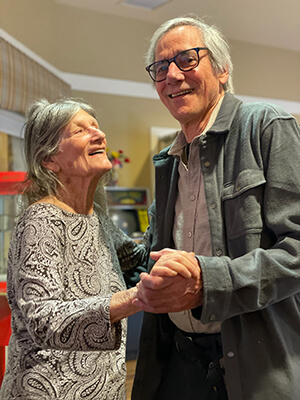
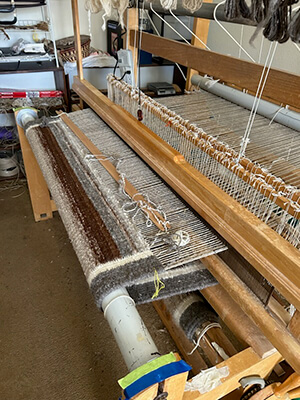
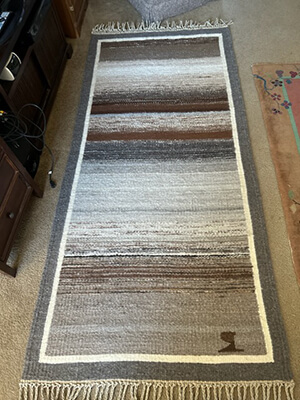
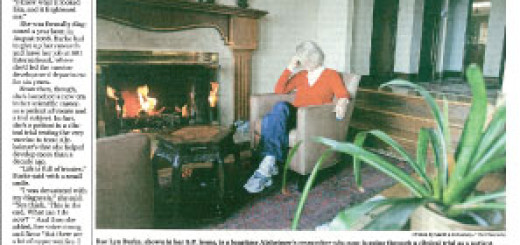
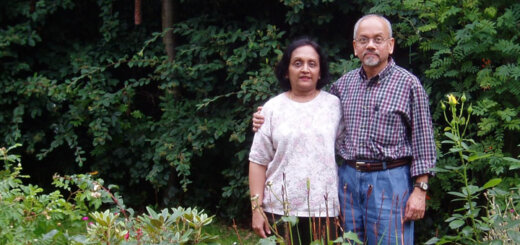
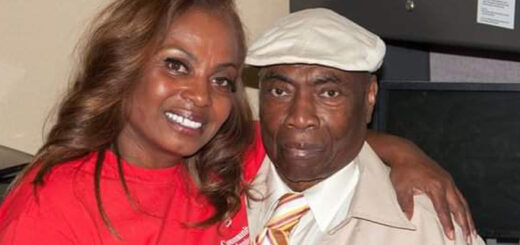



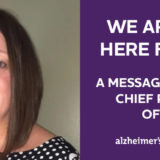






Judith and I did the Walk to end Alzheimer’s to give us closure and to be with others after her mothers passing in 2003 from a form of dementia.